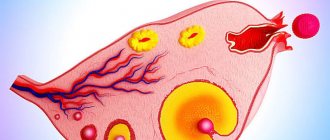Measurement Rules
Before talking about specific values, it is important to find out exactly how basal temperature should be measured before menstruation. The most accurate readings will only be provided that a number of conditions are met. So, it is advisable to take measurements at the same time, in the morning, until the woman gets out of bed. Doctors recommend monitoring your basal temperature rather than taking measurements in the mouth or armpit. It is believed that in the rectum it is most reliable.
It is also important to sleep at least 4 hours before the measurement. In addition, it must be remembered that during illnesses that are accompanied by an increase in temperature, there is no point in taking such measurements, the picture will be distorted. Any intestinal disorders, significant changes in daily routine, taking sleeping pills, or alcohol can also affect morning performance. On these days, the temperature may not be measured or not taken into account when calculating average values.
https://youtu.be/r-h1KOBCyo8
How to understand that you are pregnant? Signs of early pregnancy
How easy is it to understand that you are pregnant? First of all, you need to understand that the Internet and useful articles will not give an exact answer to the question. This can only be resolved by taking a test and then visiting a doctor. However, if you suspect, pay attention to some signs indicating pregnancy in the early stages. How to easily understand that you are pregnant and which test is better - read the article.
Signs of pregnancy
We remind you that only a doctor can give an accurate result. But if you have these signs, contact your gynecologist to confirm the presence of pregnancy in the earliest stages. But first you should purchase a special test. To find out if you are pregnant, pay attention to these signs.
Possible signs of pregnancy:
- Delay of menstruation for more than 7-10 days;
- Chest pain;
- Sensitivity to strong odors;
- Changes in tastes in food, smells, etc.
- Fatigue and decreased immunity;
- Frequent urge to urinate;
- Increase or decrease in libido;
- Morning sickness, vomiting;
- Mood swings.
Many mothers admit that during early pregnancy they had dreams that in one way or another meant expecting a child: dreams about fish, eggs and other symbols. Of course, there is no scientific evidence of the connection between dreams about fish and new additions to the family, but one cannot so easily write off the experience of many generations of women.
Many of these symptoms may indicate not only the birth of a new life, but also many other factors. The absence of menstruation and pregnancy can be a consequence of both taking OCs and their discontinuation. A delay in menstruation may indicate stress, excessive physical exertion, hormonal imbalance and some other gynecological problems not related to the interesting position.
Many women experience chest pain before their period begins, so this symptom is also difficult to call accurate. This may also include sensitivity to strong odors, urge to go to the toilet, and mood swings. Nausea and vomiting can be signs of poisoning and problems with the gastrointestinal tract.
Fatigue and decreased immunity can also indicate physical and emotional overload. It can also be a symptom of a cold or the onset of menstruation.
During pregnancy, these signs may not be present at all. For many women, the first three weeks of pregnancy are asymptomatic. Even menstruation in some cases may persist after conception due to the individual characteristics of the woman.
Some women find out about their situation only before giving birth. That is why you should not rely on signs of pregnancy alone. All these symptoms may be just a reason to take a test or see a doctor.
Possible signs of pregnancy in the early stages:
- Two stripes on the test;
- Ultrasound confirming completed ovulation;
- Positive test when donating blood for hCG;
- The doctor who said you are pregnant.
This may sound stupid and obvious, but you can’t draw conclusions about pregnancy based only on possible signs.
Basal temperature measurement
Basal temperature is an important indicator that will help a woman find out about the onset of ovulation or pregnancy. The temperature is measured in the anus, vagina or mouth.
It changes under the influence of changes in a woman’s hormonal levels during pregnancy and ovulation.
Such a measurement will help a woman control not only the origin of life inside, but also be aware of hormonal changes that may be unhealthy.
What is the temperature during pregnancy?
At the beginning of ovulation, the normal basal temperature in women is 37.2 degrees. When planning children, this indicator is important to take into account.
When pregnancy occurs, the possible temperature range is from 37.1 degrees to 37.3.
Please note that if a pregnant woman’s basal temperature drops to 37 degrees or lower, this means that the level of progesterone in the body has dropped. This can lead to early miscarriage. Therefore, if you have already had spontaneous abortions, then during your next pregnancy it is advisable to monitor this indicator.
How to measure basal temperature?
- Measure it in the anus, vagina or mouth (your choice, not in that order).
- Measurements should begin on the first day of the start of the cycle (when menstruation should occur).
- Take measurements in the morning at rest, before you get out of bed. Take measurements at the same time.
- Keep notes where you will record the data of each measurement. Also write down how you feel at these moments.
Measure your basal temperature only once a day and only at rest, excluding stress. Ideally, you should measure your temperature after 6 hours of sleep or more. So that the body is rested.
Then the results will be accurate.
Pregnancy test - which is better?
In order to choose which pregnancy test is best, it is useful to find out what types there are. Most manufacturers recommend using it on the 7-10th day of delay.
But some suggest finding out the exact result within a week after the expected conception. The accuracy depends on the sensitivity level of the device; for more expensive ones it is higher.
If you need to know the result at the earliest possible date, you should pay attention to highly sensitive tests. Let's figure out what types of pregnancy tests there are and which one is better.
- Test strip;
- Tablet;
- Jet;
- Electronic;
1. Test strip - the most common type. Its advantages are its low price and fairly accurate results. Many women buy several of these strips at once to be completely sure of the result, but this is not always wise.
Firstly, for the price, several cheap strips can work out as one more accurate one. The possibility of a false result may occur very early in pregnancy.
It is worth redoing a false negative test after a couple of days and the result may change, because every day the pregnant woman has a level of hCG, which affects the result.
https://youtu.be/NBwlMtLRz00
The disadvantages include inconvenience of use. The strip should be lowered into a container with urine for 5-10 seconds. This is less convenient than using an inkjet device. Another disadvantage is the likelihood of an inaccurate result in the early stages.
2. The tablet is essentially the same test strip, only it is located in a special frame. Its effectiveness is identical to the strip, the only difference is in use. For the test, you need to collect urine in a container.
Using the measuring pipette that comes with the kit, take a little of the contents and drop it onto the indicator. Perhaps this process is convenient for some, but this is purely individual.
The price is much higher - the effectiveness is the same.
3. The jet test is the most convenient, since it does not require collecting the urethra anywhere. The device is immediately placed under a stream of urine, closed with a cap, and the result is expected. The price, of course, is much higher than the previous ones, but the efficiency and convenience pay for themselves.
4. The electronic test detects the level of hCG in the same way, you also need to pee on it, like with a jet test, and the effectiveness is also good. The only difference is an electronic indicator that will say “you are pregnant” or not. It may be able to create a solemn mood, but the price-quality ratio does not justify itself.
How not to determine pregnancy?
Try to do without the “grandmother’s” methods of determining pregnancy, when urine is boiled and iodine is poured into it and covered with soda. There is no practical proof of the effectiveness of these methods. Besides, living in the 21st century and having a sufficient number of pharmacies nearby, is it worth torturing yourself and your family with such outdated methods? Take pity on your homemade dishes!
You should not determine pregnancy online. At best, this is just a stupid joke, especially do not send money to strangers who promise to predict the birth of your child. It is impossible to find out about your situation online.
Source: https://imom.me/kak-legko-ponyat-chto-ty-beremenna/
Plotting a graph
It should be noted that there are general average indicators of what the basal temperature should be before and after menstruation, during ovulation, as well as during other periods of the cycle. But each organism is individual, so in order to understand whether there are problems with the reproductive system, it is necessary to regularly record the obtained values and build graphs. Possible diseases are judged by temperature fluctuations, by the difference in indicators in the first and second phases, and by the nature of their changes. The graph is constructed as follows: the days of the cycle are marked on the horizontal axis, and the measurement values are marked on the vertical axis. Normally, two phases should be clearly visible on it. In the first of them, the temperature is lower and is at 36.5 degrees, and in the second, which occurs after the release of the egg, it rises to 37 or more. To understand whether there are any problems, doctors recommend taking the average values in each phase. The difference between them should be at least 0.4 degrees.
Atypical temperatures
There are possible deviations from the norm due to disease or hormone imbalance, which is reflected in other indicators on the graph. The most typical examples of deviations:
Progesterone deficiency
- Progesterone deficiency, causing a tendency towards the downward curve of the graph. It is characterized by a slow rise in temperature, which lasts no more than a week. The difference in digital values between the phases becomes less than 0.4°, the second period of the cycle is shortened to 10 days instead of 14, which causes menstruation to appear prematurely;
With progesterone deficiency, the basal temperature first decreases, then rises and lasts for about two weeks.
Endometritis
- Endometritis, inflammation of the uterine mucosa, on the contrary, increases the temperature in the first menstrual days to 37°. This is the basal temperature before menstruation and on the first day of bleeding that is the hallmark of this disease. When, after a slight decrease before the start, instead of continuing to drop, an increase in indicators is observed, it is clear that you cannot do without consulting a doctor;
The basal temperature before menstruation and on the first day, if there is an inflammatory process such as endometritis, is kept at 37°.
Pregnancy
- When pregnancy is confirmed, when the temperature remains elevated - up to 37.5°, menstruation does not begin on time, and blood discharge from the vagina is noted, indicating a threat of miscarriage. If the test is negative and the temperature is high, an ectopic pregnancy may develop;
During pregnancy, the basal temperature will remain at a level of up to 37.5°C for quite a long time.
Lack of ovulation
- Lack of ovulation, when the resulting graph is a set of chaotic points, sometimes high, sometimes low, without a clear boundary between the phases;
Inflammation of the appendages
- Inflammation of the appendages increases the thermometer readings, both in the first period of the cyclic process and in the second. In the first half of the graph, an increase to 37° is recorded, followed by a decrease. In the second, what basal temperature before menstruation will be 2 days later, the same remains the same further, reaching a value of 38 °.
In the second cycle, with inflammation of the appendages, the basal temperature before menstruation will remain at 38 °.
Cyclical changes
If the indicators in the first and second phases are clear, then the question of what the basal temperature should be before menstruation worries many women. Ideally, in the second phase, which begins after ovulation, the values should be above 37 degrees. By the beginning of menstruation, they may decrease slightly. The first days of menstruation are characterized by the fact that the temperature drops every day, reaching a level of 36.5-36.8 degrees by the end.
Before ovulation, it may drop even more and rise sharply immediately after the egg is released. This indicates that the second phase has begun. If you measure indicators regularly, you can suspect various problems based on deviations in the values. Despite the fact that many talk about the pointlessness of measurements during critical days, the temperature during this period can tell you what aspects of women's health are worth paying attention to. Basal temperature should drop during menstruation; if this does not happen, then you should think about undergoing an examination.
Possible diseases
On average, a couple of days before the discharge begins, the indicators should begin to decrease. A gradual decrease in temperature should also occur during critical days. If, instead of a decrease during menstruation, there is a sharp rise to levels of about 37.6 degrees, then this may indicate the development of endometritis or endomyometritis. Of course, an increased basal temperature during menstruation should alert you, but making a diagnosis based on only one measurement is unacceptable.
But in the case when in the second phase the temperature barely reaches 37 degrees, but with the onset of critical days it rises above this level, inflammation of the appendages can be suspected. In addition, measurements make it possible to identify problems with the tubes or cervix. It is worth talking about probable inflammation of these organs in cases where temperature readings increase by the 4-5th day of menstruation. It is worth paying close attention to those cases when the basal temperature before menstruation is 37.2. If it does not drop significantly with the onset of your critical days, then it is better to do a test. Perhaps this is a pregnancy with a threat of termination. But if the temperature rises for one day, then do not worry, this does not mean anything. Also, do not forget that measurements alone are not enough to make a diagnosis; this will require a series of examinations.
Why does body temperature change before menstruation?
Menstruation is a natural process associated with hormonal changes. The body's increased work on the synthesis of progesterone affects thermoregulation, which is why the body temperature before the onset of menstruation jumps to 37°C, and this is normal. The physiological reasons for this phenomenon are:
- PMS. Premenstrual syndrome is a complex of symptoms that manifests itself to varying degrees 2 to 10 days before bleeding. Deterioration in general well-being and hyperthermia are associated with hormonal fluctuations, changes in metabolism and the functioning of the nervous and cardiovascular systems. As the temperature rises, chills, flatulence, headache, swelling of the face and limbs, and changes in blood pressure are observed. An excessive reaction to everyday troubles leads to depression.
- Increased blood flow to the ovaries. The thermometer readings may deviate from the norm 2 to 3 days before the onset of bleeding if the body is sensitive to the approach of menstruation. With severe PMS, a slight rise in temperature is observed 10 days before menstruation, i.e. in phase 2 of the cycle.
- Pregnancy. With the onset of pregnancy, body temperature may change upward. The woman does not yet know about conception, but in the earliest stages of gestation there is a delay in menstruation and a temperature of 37 degrees. Instead of menstruation, implantation bleeding occurs, which occurs when the embryo attaches to the uterus. An attentive woman will definitely notice not only hyperthermia and spotting, but also rapid fatigue, frequent urination, engorgement of the mammary glands, a reaction to odors, and the appearance of nausea in the morning. If, in addition to low-grade fever, the basal temperature in the rectum remains elevated, and menstruation does not begin, in most cases this indicates successful fertilization of the egg.
First phase
Having understood the temperature during critical days, you can find out how the body should behave after their end. Normally, the thermometer readings should be around 36.6, but they will depend on the personal characteristics of each girl or woman. For some, they will remain at 36.4 throughout the first phase, for others they can rise to 36.8 degrees. But both of the described cases are quite acceptable.
But a more significant rise in temperature indicates that it is better for a woman to consult a gynecologist. If the indicators in the first phase approach 37 degrees, then this may indicate a lack of estrogen. But this can only be confirmed with a blood test for hormones. You should also be wary if your basal temperature rises during menstruation and periodically increases for 1-2 days throughout the first phase to 37 degrees and above. This may indicate inflammation.
Increased temperature before menstruation and its delay
In this case, consider the increase in basal temperature and the absence of menstruation at the prescribed time. In such a situation, when temperatures reach 37°C, there is a high probability of successful fertilization of the egg, that is, this phenomenon indicates the onset of pregnancy. The indicators rise as usual, as before menstruation, but the physiology of this process is completely different, although it is also caused by hormones.
To confirm or deny the presence of pregnancy, it is enough to purchase a special pregnancy test at the pharmacy, based on determining the level of human chorionic gonadotropin in the urine. This substance begins to be actively produced after the embryo attaches to the wall of the uterus, and every day its amount in the body increases significantly.
It is worth noting that only rectal temperature is measured both before and after menstruation. This is the only way to notice minor changes.
Conventional measurements, when the thermometer is placed in the armpit area, will not give correct results. The latter can only be used during colds. Everything related to reproductive function (menstruation, ovulation, pregnancy) is measured only by inserting a thermometer into the anus.
The indicators rise when ovulation occurs, and decrease just before menstruation. This process indicates the absence of fertilization and the imminent onset of bleeding. If pregnancy has occurred, the temperature will remain at 37°C for a long time, and bleeding will not occur.
Fever before menstruation, accompanied by other symptoms
Minor fluctuations that slightly exceed 37°C are not a pathology and are caused by natural processes of the body. Treatment in this case is not required.
If a woman notices brighter fluctuations, which are observed not only before monthly bleeding, but also on other days of the cycle, then we can assume the presence of an inflammatory process that is localized in the genital area. When such a clinical picture appears, medical intervention is required, and as soon as possible.
Types of pathologies that can accompany elevated temperature:
- Inflammation of the appendages. If the basal level before menstruation exceeds the norm, then most likely an inflammatory disease is occurring. However, this process is usually accompanied by other symptoms - nausea, which can lead to vomiting, chills, general weakness, sharp aching pain in the abdominal area, discomfort when urinating;
- Endometritis is inflammation of the inner layer of the uterus. Symptoms, in addition to fluctuations in the thermometer reading, may include increased heart rate, as well as dull abdominal pain. Sometimes there is diarrhea and discomfort when visiting the toilet;
- PMS – premenstrual syndrome. Very often at this time the nipples are cut, irritability occurs, but unlike the above pathologies, the thermometer mark does not exceed the permissible limits.
Why does the temperature rise during menstruation?
Changes in indicators can be observed directly on these days. Specialists in the field of gynecology agree that minor fluctuations are not a deviation from the norm.
- This is due to the fact that critical days are a kind of stress for the body, as they are accompanied by severe blood loss and dehydration. This is why some particularly sensitive women may experience weakness and apathy, and the thermometer rises due to simple fatigue.
But strong fluctuations, especially those accompanied by pain, are a pathology. In such a situation, it is necessary to contact an antenatal clinic and undergo diagnostic procedures to find out the cause of the pain. The fact is that the normal concentration of sex hormones in the blood does not cause discomfort during menstrual periods. And if discomfort occurs, it means that there are disturbances in the body. During monthly bleeding, the thermometer mark may rise due to inflammatory diseases of the uterus.
- Before the start of the critical days, the neck of the organ (cervical canal) expands slightly, and accordingly, pathogenic microorganisms easily penetrate into the organ. This often leads to inflammation of the endometrium. To avoid this, it is necessary to adhere to preventive measures, for example, using sanitary pads rather than tampons. In addition, you must strictly observe intimate hygiene.
- An increase in readings during or before menstruation is in some cases a symptom of infectious diseases of the gastrointestinal tract. This is due to the fact that menstrual periods often provoke diarrhea. Although this disease is not directly related to the reproductive system, it is advisable to undergo diagnostics.
Indicators during ovulation
An unusual basal temperature before or during your period may indicate a number of problems. But measurements on other days are no less indicative. Normally, the next morning after the release of the egg, a woman observes an increase in temperature. It can be either sudden or gradual. For some, on the very first day it increases by 0.4 degrees, for others this difference increases in 2-3 days. Both of these situations are completely acceptable. In the case when the rise in values takes more than 3 days, one can suspect the inferiority of the egg released from the ovary or a lack of estrogen. As a rule, it is almost impossible to get pregnant in such a cycle.
Basal temperature before menstruation: what should be the indicators?
One of the most important indicators of the health of the female reproductive system is the menstrual cycle. Based on the regularity and duration of each phase of the cycle, a woman can draw a conclusion about the state of her reproductive system.
Along with the cyclicity and duration of menstruation, the processes occurring in the reproductive system are indicated by basal temperature.
What is hidden behind this concept? What should be the basal temperature before menstruation?
Basal temperature - what is it?
Under the influence of physiological processes, the temperature inside the human body is constantly changing. The female reproductive system is particularly influenced by hormones, which have different concentrations on different days of the menstrual cycle. They are the ones who influence internal temperature indicators when a woman is healthy.
However, when recording the temperature in the armpit, minor changes will not be noticeable. Measuring basal temperature allows you to catch the slightest fluctuations in indicators. BT is the lowest daily body temperature, which is recorded when a person wakes up after a full sleep.
Basal temperature differs from normal temperature in that it is measured only on mucous membranes. It is measured in three ways:
- in the mouth;
- in the vagina;
- in the rectum.
Of the listed methods, the rectal method is considered the most reliable. BT is widely used in gynecological practice as a method of diagnosis and control. However, in order for the measurement of basal body temperature to be informative, it is necessary to take measurements and record the indicators every day for several cycles.
What can basal temperature indicate?
Based on daily data, a woman can trace an individual graph of temperature fluctuations in different phases of the monthly cycle. Recording basal temperature allows you to identify:
- The beginning and end of the menstrual stage. Each phase corresponds to certain temperature indicators. Based on the data, the duration of each of them is tracked.
- Favorable days for conception. There is only one day during the cycle when the egg is ready for fertilization. BT allows us to identify this period.
- Development of the inflammatory process in the reproductive system. Every woman's body is individual. However, there are general standard temperature indicators. If the temperature deviates significantly from the norm, this indicates the development of the disease. Pathology is also detected when the current temperature graph differs from the previous ones.
- Onset of pregnancy. The internal temperature after fertilization remains stable throughout the entire period of gestation. Stability of indicators after ovulation indicates fertilization.
- Hormonal disorders. Deviations from the norm are also evidence of disruptions in the hormonal system. Each phase of the menstrual cycle is influenced by a specific hormone. Depending on its concentration, BT changes. If the hormone is insufficient or in excess, the temperature will deviate from the norm.
Basal temperature charts allow gynecologists to confirm infertility, pregnancy, and diagnose threatened miscarriage and hormonal deficiency. This diagnostic method is not used separately, but in combination with other methods it allows one to obtain a reliable result. Data for 3 months or more are considered informative.
How is BT measured?
The peculiarity of basal temperature is that its indicators are influenced by many factors. Significantly distort the data:
- diseases accompanied by increased body temperature (colds, viral and bacterial infections);
- alcoholic drinks consumed the day before;
- short sleep;
- sudden movements;
- eating, drinking;
- change in measurement time;
- overheating or hypothermia of the body;
- endocrine pathologies;
- medications.
To obtain a reliable result, it is necessary to measure the temperature in the rectum. Use a mercury or electronic thermometer. However, it should be borne in mind that the electronic instrument shows the result in approximately 1 minute, and the mercury instrument - in 5-7 minutes. Basic rules for measuring BT:
- The temperature is measured in the morning immediately after waking up. The night before, you need to put the measuring device in a place where you can get it without getting out of bed. It is recommended to take measurements from 6 to 7 am.
- For measurements you should always use the same measuring device. If for some reason this is not possible, you should purchase a similar one.
- The thermometer should be inserted approximately 2 cm into the rectum. You can't get out of bed. The thermometer is inserted while lying on your side or stomach.
- Sleep on the eve of measurements should be at least 5 hours. The most reliable information is revealed when sleeping more than 6 hours a night.
- The measurement time cannot be changed. Fluctuations within 1–2 hours are allowed.
- When scheduling BT, you cannot take hormonal medications. Medicines affect natural hormone levels, so the information is not representative.
- If on the eve of the measurement there were factors influencing the results, this should be noted in the graph.
What should BT be on the eve of menstruation?
However, there are norms of change that need to be guided by. To determine personal indicators indicating a particular phase of the cycle, the following must be taken into account:
- on the first day of the cycle (beginning of menstruation) the indicator reaches 36.7–37 degrees;
- then the temperature decreases, on the last day of menstruation it approaches 36.2–36.6;
- when the egg matures, the temperature indicator is 36.6–36.9;
- on the eve of ovulation, the thermometer shows a decrease of 0.2 degrees;
- on the day the egg leaves the follicle, the thermometer column rises sharply and shows from 37 to 37.5 degrees;
- further indicators may fall by 0.1–0.2 degrees, but will remain above 37;
- if fertilization does not occur, before menstruation the temperature will drop by 0.2–0.4 degrees.
Thus, basal temperature indicators before menstruation depend on the time remaining before the start of the menstrual cycle.
Beginning of the second phase
If the indicators after the release of the egg do not reach 37 degrees, then this may indicate inferiority of the corpus luteum. But it is not worth talking about the insufficiency of the second phase only by the temperature value. It is important to look not at the indicators themselves, but at the difference in values that were in the first and second part of the cycle. If measurements are taken in degrees Celsius, then during normal functioning of the body it will be 0.4 or even higher. Although it is not worth making any diagnoses without an examination. Insufficiency of the second phase and the prescription of progesterone drugs is possible only after an appropriate analysis.
End of the second phase
Regardless of what exact values a woman had after ovulation and before it, the basal temperature before menstruation should begin to decrease. Moreover, its value by the first day of the cycle should not normally exceed 37 degrees. If according to the schedule, ovulation took place more than 14 days ago, and the temperature does not drop, then you can do a test that helps to diagnose the conception of a baby in the early stages. A basal temperature before menstruation of 37 degrees is considered quite normal. But it is important that it decreases with the onset of discharge. If menstruation has begun, and the elevated temperature lasts for several more days and drops only towards the end of the critical days, then this may indicate a miscarriage.
BT standards at different stages
It is quite natural for the female body that BBT changes during the cycle. But to determine what is normal, it is necessary to carry out measurements for at least 3 months in order to obtain reliable data. Let's consider what the acceptable BT values are at different stages of the menstrual cycle, as well as what this or that temperature can mean during systematic measurements, and how many days before menstruation its value begins to fall.
You need to start drawing up a schedule on the first day of your period, that is, on this day you need to take the 1st measurement. Its value increases slightly in the first days, so this indicator does not take part in the calculations. On average, basal temperature during menstruation can fluctuate between 36.3-36.5 ° C; this value can remain the entire 1st phase of the cycle. These are optimal conditions for follicle growth under the influence of the hormone estrogen.
Immediately before a mature egg is about to leave the ovary, BT begins to fall by a few tenths of a degree, and then sharply increases to 37-37.2 ° C. An increase in basal temperature indicates the onset of ovulation and the beginning of the 2nd phase of the cycle; such indicators can remain until the end of the cycle.
What the basal temperature will be before menstruation depends on the state of the egg: whether it is fertilized or not. At the site where the follicle breaks through the wound on the wall of the ovary, a corpus luteum forms, which produces the hormone progesterone. The result of fertilization largely depends on it. Under the influence of progesterone, BT increases to 37.0-37.5°C. This is the best time to conceive. Until the end of the cycle, the graph will show values within these limits. When conceiving, similar indications are noted before and after the delay - this is the surest sign of pregnancy. To confirm its occurrence, you can additionally use a test.
A week before your period, normal basal temperature can remain around 37°C, the highest point should not exceed 37.5°C. One nuance must be taken into account that with a 4-week cycle, it is at this time that implantation retraction can be observed - BT decreases by several tenths of a degree during the implantation of the embryo into the uterine wall. In this case, the expectant mother may feel pain in the lower abdomen, and minor bleeding may also occur. Not every woman may experience a decrease in BT during embryo implantation, but over time the value still levels out. If fertilization does not occur, then the level of progesterone drops, and this leads to a decrease in BT on the eve of menstruation.
3 days before menstruation, BT is usually characterized by a drop of 3-5 tenths of a degree. A variant of the norm during this period will be considered its value in the range of 36.7-37.1°. But in general, for each woman before her period, the norm of basal temperature will be individual.
By measuring basal temperature, you can assess the coherence of the female body, you can say exactly when the time has come that is most suitable for conception, and specify the days on which you can not use protection during sexual intercourse. It is best to take measurements several cycles in a row to achieve greater accuracy of the results.
Since the functioning of the female body is highly dependent on hormones, it is quite natural that, due to their level, the BT value can increase and decrease. Low basal temperature is observed immediately before ovulation and in the last days of the cycle. In the latter case, this means that fertilization has not occurred and you need to prepare for the arrival of menstruation. If the basal temperature does not drop at this time, but remains at 37 and a half, or even 38°, this may indicate the presence of an inflammatory process or disease in the body. During pregnancy, BT does not increase more than to 37.2-37.5°C, which means that 38°C is an alarming signal for a woman, meaning that she urgently needs to see a doctor.
The basal temperature after menstruation remains within the range of 36-36.9 ° C, but if it remains at this level throughout the entire cycle, it means that this month the reproductive system decided to rest, since when ovulation occurs there would be a temperature rise. Pregnancy will not be possible during this cycle. You only need to panic if a similar situation repeats several cycles in a row - this is a reason to seek help from a specialist.
Duration of phases
In addition to knowing what your basal temperature should be before your period, it is important to know how long each part of the cycle can last. Thus, the length of only the second part is relatively constant; depending on the characteristics of the body of each individual woman, it can be 12-16 days. But the ideal option is one in which it lasts 14 days. But the long first part of the cycle can range from 10-12 days to several weeks. Of course, with a cycle of 28 days, it lasts about 14 days, during which time the follicle has time to mature and ovulation occurs. But for some women it can be much longer. At the same time, their body goes through all the necessary stages: growth and maturation of the follicle, release of the egg, formation and functioning of the corpus luteum.
Standard options
It’s not worth talking about certain diseases based solely on temperature levels. But this information is needed in order to suspect some problems and undergo the necessary studies to confirm or refute the diagnosis. At the same time, it is impossible to judge by just one cycle; measurements must be taken over at least three months. If the picture repeats every month, then together with the gynecologist you can draw any conclusions by analyzing how the basal temperature changes before menstruation. The norm for it cannot be established in absolute values. It depends on both the values in the second and first phases. If a woman’s readings before ovulation are around 36.4 degrees, then after it they may not exceed 36.9. At the same time, an increase in temperature to 37 on the day of menstruation will not indicate the approaching critical days, but the onset of pregnancy.
Pathological causes of fever before menstruation
Often, an increase in temperature before menstruation indicates the presence of pathology in the body. Be sure to consult a doctor in the following cases:
- The rise in temperature at the end of the cycle is strong and sudden, this picture is not typical for a woman. At the same time, symptoms of malaise, aching in the bones and muscles are pronounced.
- This condition is accompanied by uncharacteristic colored discharge with an unpleasant odor and unusual consistency. There are any irregularities in the menstrual cycle.
- The temperature does not subside during menstruation, as well as after it.
If the temperature before menstruation rises to 38° and even higher, the condition is aggravated by sharp pain in the abdomen, and sometimes in the mammary glands, menstruation is painful, this indicates the occurrence of inflammatory processes in the uterus (endometritis - inflammation of the endometrium) or in the appendages (adnexitis - inflammation of the ovaries, or salpingoophoritis - inflammation of the ovaries and fallopian tubes). In this case, the temperature rises to 39°-40°.
This condition does not stop with the onset of menstruation, but can occur during the cycle. The woman experiences nausea and vomiting and nagging pain in the lower back. At the same time, symptoms of bladder inflammation (burning, cramping, pain, increased frequency of urination) may occur. In this condition, you cannot postpone a visit to the doctor. Urgent treatment is required, since as a result of the disease, adhesions may occur in the appendages, which leads to infertility.
Anovulatory cycles
Ideally, a woman should have a two-phase basal temperature chart. Before menstruation, it decreases slightly, but the difference between the average indicators of the first and second half of the cycle is within the norm. But it is quite acceptable if there is no ovulation once or twice a year. In this case, the indicators may change every day, the temperature may rise or fall sharply. This does not indicate any problems, just that there will be no ovulation this month.
Important nuances
If on any of the days before the measurements the normal daily routine was disrupted, then the temperature will not be indicative. If you drank alcohol in the evening, got up a couple of hours before the measurement to go to the toilet, or were close in the morning, then the values obtained may differ significantly. Even a simple stomach upset or stress the day before can cause fluctuations in the temperature curve. This, by the way, is one of the reasons why it is impossible to judge a woman’s health status on the basis of just one graph. But it should also be noted that even an ideal graph, in which two clear phases emerge with a good difference in indicators, and the basal temperature before menstruation is 36.9 degrees, does not yet mean that the woman is in excellent health. For example, measurements will not provide any information about the size of the endometrium in the uterus or adhesions in the tubes. Therefore, even with normal indicators, you should not neglect visits to the gynecologist.
What can you learn from a temperature change graph?
By comparing graphs of temperature changes over several months (preferably at least 12), a woman will be able to determine on what day of the cycle she ovulates, and therefore determine the time of possible conception. For some, this helps to roughly determine “dangerous days” in order to be especially careful in protecting themselves before their onset. However, the probability of error is quite high. Even completely healthy women can have unexplained problems before menstruation, at least occasionally. Therefore, you should not trust this method 100%.
Based on the shape of the resulting curve line, it is determined whether ovulation occurs in each specific cycle, and a conclusion is drawn about whether the ovaries function effectively enough and whether the production of female sexual hormones corresponds to the norm.
Based on the location of temperature points on the eve of menstruation, an assumption is made that fertilization has occurred and the onset of pregnancy is established at the earliest stage. The doctor will be able to confirm or refute this assumption after palpation of the uterus and ultrasound examination.
Video: What is the importance of measuring basal temperature
https://youtu.be/JU8koMaYGfA










